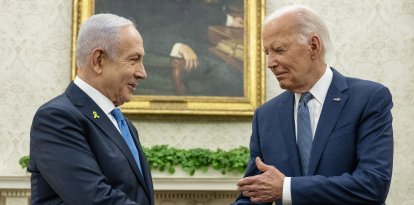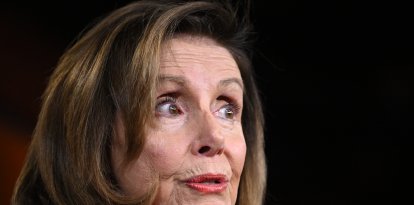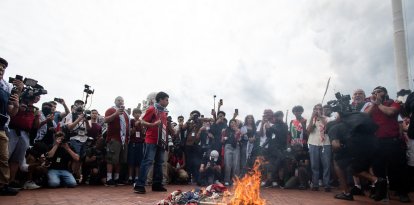Several senators present a bipartisan agreement to end the border crisis and send aid to Ukraine and Israel
Speaker Johnson announces that the plan, which includes a "shutdown" of the border if more than 8,500 migrants pass in one day, "will be dead on arrival" in the House of Representatives.

(Cordon Press)
The chaos at the border has spread throughout the country. Sunday's events left new signs that the fracture caused by the Biden Administration's immigration management reaches into all places and institutions in the country. The collapse of the sanctuary cities due to the shipments of buses loaded with migrants was added to the presentation of a bipartisan agreement in the Senate rejected by a large number of Republicans, and of which the speaker of the House of Representatives even stated that it is a proposal that "will be dead on arrival" if they finally had to vote on it. As if that were not enough, 13 of the 25 conservative governors who signed a manifesto in favor of Texas' right to self-defense held an event with Greg Abbott in one of the hottest moments of confrontation between the administrations to maintain their challenge to the Federal Executive.
A "dead on arrival" agreement
The leader of the Democratic majority in the Senate, Chuck Schumer, was delighted to present a bipartisan agreement of some 118 billion dollars that includes 20 billion for the border with Mexico and aid packages for Ukraine (60,000) and Israel (14,000), and even Taiwan. A pact that was already in the eye of the hurricane during its negotiation, with Senator James Lankford as the main leader from the conservative side and that has now finished exploding once presented. In fact, the Oklahoma Republican Party wants to officially censure Lankford in rejection of his participation in the drafting of the bill and speaker Johnson made it clear that this is a "dead on arrival" proposal in the House of Representatives.
Democrats only need 9 Republican senators to pass the bill
However, Schumer only needs the yes of 9 GOP members of the Upper House to be able to move forward with the plan, which has raised suspicions and more division among conservatives. The veteran leader of the Democrats in the Senate also highlighted the "full collaboration" of the Republican minority leader, Mitch McConnell, who was the one who appointed Lankford as the Republican representative in the talks. In addition to him, the architects of the bill are Democratic Senator Chris Murphy and Independent Senator Kyrsten Sinema.
Expulsion authority
Throughout the 370 pages, the promoters of the project assure that they have laid the foundations to repair the national immigration system and even include measures thanks to which the migratory avalanche will lose strength. Something in which critics disagree, in addition to denouncing that the text is full of traps and "legal loopholes" that make it "worse than expected," in the words of spokesman Johnson.
One of the stand out measures, highlighted by negotiators and leaders, is the activation of the expulsion of immigrants if more than 8,500 arrivals are exceeded in one day or if 5,000 are registered for seven consecutive days. In fact, if they exceeded 4,000 per day for a week, the Secretary of Homeland Security, Alejandro Mayorkas, could invoke the authority to proceed with the expulsion. However, critics denounce that the wording of the rule leaves some traps that turn this initiative into an empty gesture, such as the activation clauses, listed on page 122 of the agreement:
Crossing of criticism
Those who oppose the rule emphasize that the supposed "mandatory" is, in reality, a political option for the Executive, which leaves its activation in the hands of Mayorkas and the president: "Whenever the border emergency authority is activated, the Secretary shall have the authority, in the Secretary’s sole and unreviewable discretion, to summarily remove from and prohibit, in whole or in part, entry into the United States of any alien identified in subsection (3)(a) who is subject to such authority in accordance with this subsection."
Lankford himself came out against the criticism, which he described as "absurd and untrue," pointing out that "the emergency authority is not designed to let 5,000 people in, it is designed to close the border and turn 5,000 people around."
Something that Sinema elaborated on, stating, both in statements to CBS and in her X account, that this proposal ends the "catch and release" policy currently in force.
No to "do-gooder legislative efforts"
Something that Republicans do not seem very willing to accept. Thus, the leader of the conservative majority in Congress, Steve Scalise announced that the rule "will not receive a vote in the House of Representatives" and pointed out the second major point of disagreement, that the pact "gives automatic work permits to asylum recipients—a magnet for more illegal immigration." The president of the House National Security Committee, Mark Green , also attacked the pact, stating that "I will vehemently oppose any agreement that legitimizes or normalizes any level of illegal immigration. We must end this historic border crisis, not with do-gooder legislative efforts, but by enforcing the law."

























